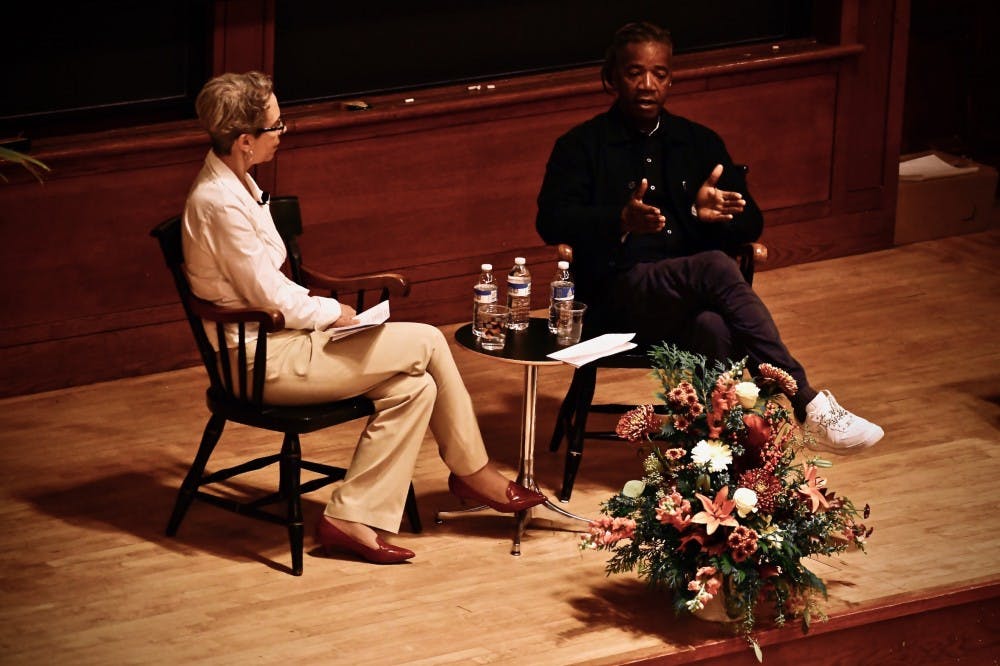In the midst of asking acclaimed artist and 2019 MacArthur fellow Walter Hood about how he expresses history through his art, Vice Provost for Institutional Equity and Diversity Michele Minter was cut off by a deafening ring, coming from the microphones, which filled the auditorium for 11 seconds.
When the sound stopped, Minter remarked, “That was mysterious.” An audience member seated in the front row loudly joked, “It was Woodrow Wilson.”
Whether or not Wilson’s ghost made an appearance in lecture hall McCosh 50 on Saturday, his presence was certainly felt. Hood and Minter spoke at “Woodrow Wilson’s Legacy: Wrestling with History,” a public conversation to mark the completion of “Double Sights,” Hood’s commissioned installation, which explores Wilson’s “complex legacy.”
Wilson, a member of the Class of 1879, served as President of the University before his election as President of the United States in 1912.
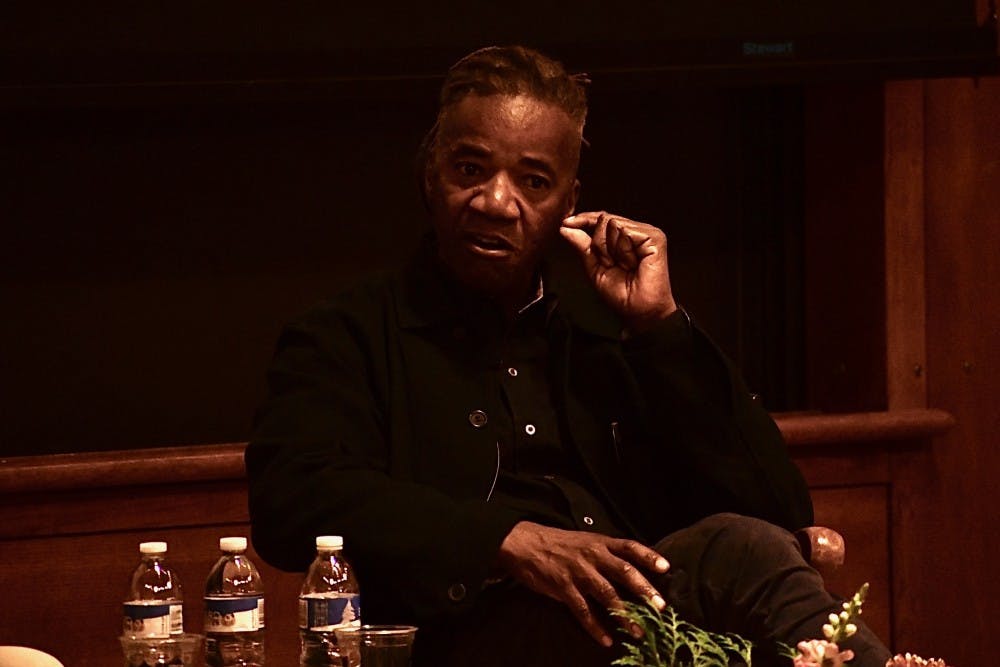
Artist Walter Hood speaks about his installation, “Double Sights.”
Photo Credit: Jon Ort / The Daily Princetonian
After the discussion, Dean of the Woodrow Wilson School Cecilia E. Rouse and University President Christopher L. Eisgruber ’83 delivered remarks in Scudder Plaza, a few feet in front of “Double Sights.” A reception in the basement of Robertson Hall, where the exhibit “In the Nation’s Service? Woodrow Wilson Revisited” is currently on display, followed.
A protest composed of students, alumni, and other community members coincided with Eisgruber’s remarks and the reception.
“Double Sights” was commissioned after the Trustee Committee on Woodrow Wilson’s Legacy at Princeton released its recommendations in 2015. The University convened the committee after the Black Justice League (BJL) organized a series of protests, which culminated in a 33-hour occupation of Eisgruber’s office, in the fall of 2015.
“I would not be here without the Black Justice League,” Hood said, to applause.
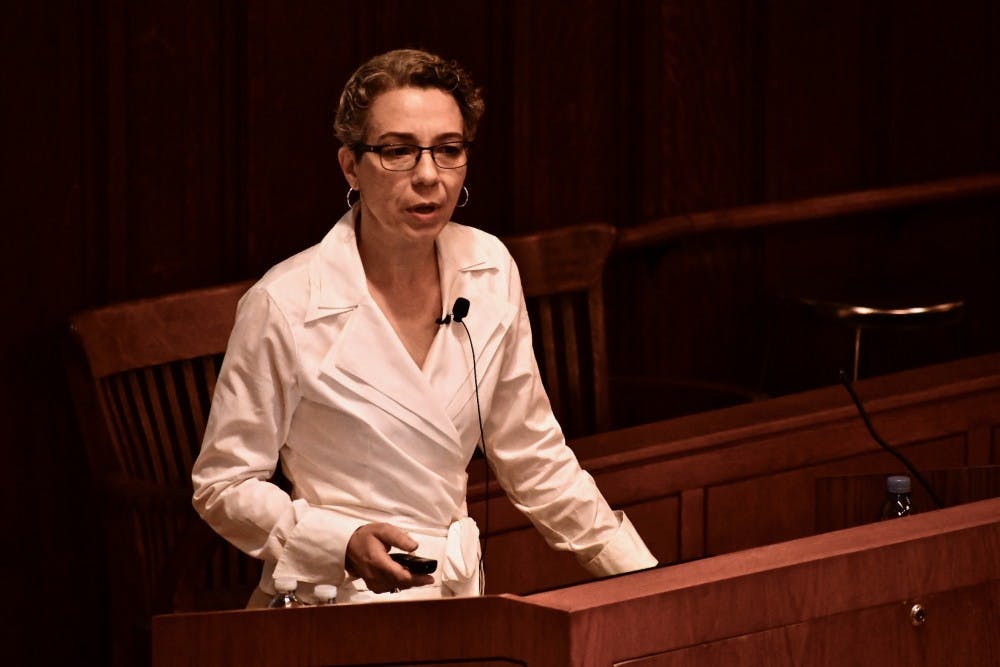
Michele Minter speaks about steps the University has taken in the wake of 2015’s BJL protests.
Photo Credit: Jon Ort / The Daily Princetonian
Among other demands, the BJL called for the University to acknowledge Wilson’s “racist legacy” and take “steps” to remove Wilson’s name from campus institutions — namely, the Woodrow Wilson School of Public and International Affairs and Wilson College. Though Wilson’s name has been retained on both the Wilson School and College, the University removed a mural of Wilson from the Wilson College dining hall in 2016.
University spokesperson Ben Chang contextualized “Double Sights” as part of the University’s efforts to promote inclusivity. At the beginning of the discussion, Minter detailed how the University has sought to do so, particularly by the renaming of Morrison Hall, Arthur Lewis Auditorium, and Rivers Way, in honor of Toni Morrison, Arthur Lewis, and Robert J. Rivers ’53, respectively. She also presented examples of new campus portraits, which depict those individuals, among others.

“The University’s expanded commitment to diversity and inclusion — outlined by the Board of Trustees in 2016 — is exemplified by programs aimed at diversifying our student body and higher education more broadly, the diversification of art and iconography on campus, and initiatives to create a more multi-faceted understanding and representation of Princeton’s history, including Woodrow Wilson,” Chang wrote in an email to The Daily Princetonian. “Double Sights is one manifestation of that commitment and sits alongside all the other initiatives underway. We consider the resources devoted to these efforts to be worthy, long-term investments in furthering dialogue and examination of issues core to our identity as a community.”

Brent Henry '69, who chaired the Trustee Committee, studies Walter Hood's "Double Sights."
Photo Credit: Jon Ort / The Daily Princetonian
Vice-chair of the Board of Trustees Brent Henry ’69, who served as Chair of the Trustee Committee on Woodrow Wilson’s Legacy, introduced the talk. Henry is no stranger to student activism on campus, having taken part in the Association of Black Collegians’ 1969 occupation of New South, in protest of the University’s investments in apartheid in South Africa.
By far the most active dialogue in the McCosh discussion took place during the Q&A period, when audience members could direct questions to either Minter or Hood. During that time, some audience members expressed disagreement with many of the University’s decisions regarding the Wilson legacy.
While he did not strictly ask a question, audience member Larry Adams ’74 used his time during the Q&A to give an impassioned speech dissenting with a number of the University’s decisions, including keeping the Wilson name on the Woodrow Wilson School.
“The University’s decision to uphold the name is a decision to hold on to its white supremacist heritage,” Adams said. “If you want to make a qualitative step, it’s the step to revisit the decision to maintain the name and take it down.”
While Minter and Hood did not immediately respond to Adams, Henry later made an unscheduled return to the stage, concluding the talk by addressing the Trustee Committee’s decision to keep the Wilson name.
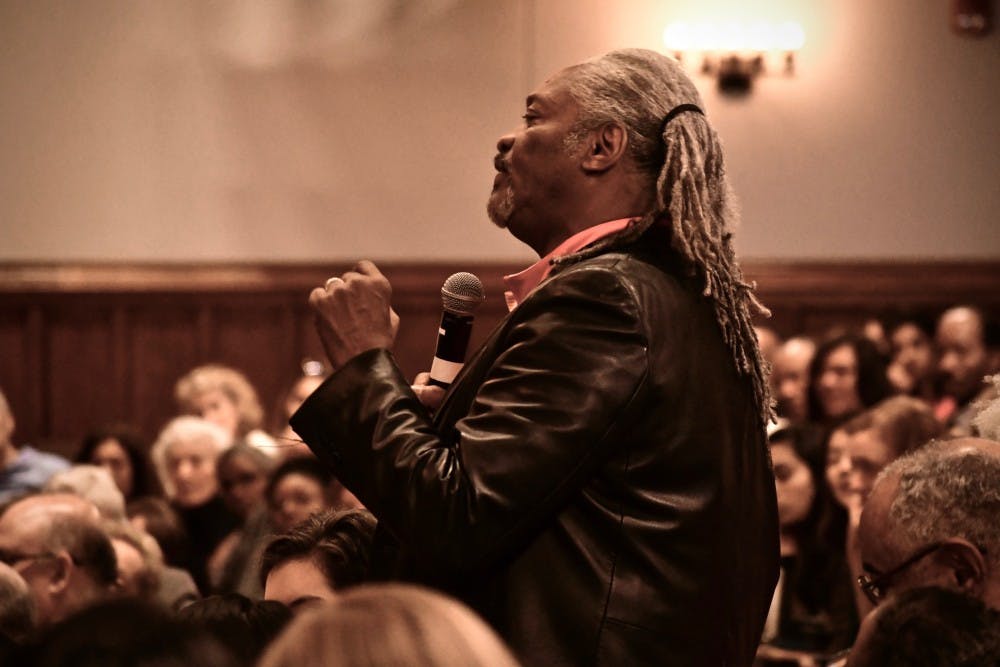
Larry Adams '74 criticized a number of the University's decisions during the Q&A period.
Photo Credit: Jon Ort / The Daily Princetonian
“In my view, the Wilson name is a symbol, and perhaps it’s a hurtful symbol to a lot of people,” Henry said. “But I must tell you, there’s a whole couple generations of us students who survived on this campus with the Wilson name, and we think, based on looking at this group today, the students here may feel some pain, but they’re doing a whole hell of a lot better than we did.”
“Some of you may not be very comfortable with the decision that we made, but it is the decision that we made,” Henry added.
Adams, along with others in the audience, were largely opposed to the marker’s creation in the first place. Among them was Brandon Holt ’15, who helped lead the students who occupied Eisgruber’s office in 2015.
“I want to challenge the premise of the statue,” Holt said. “The idea that we need a monument dedicated to a white supremacist in order for students to have a space to protest is incredibly flawed.”
In response, Minter called the installation “a really small part” of the University’s larger plan, which included the renaming of campus spaces and expansion of iconography. She also rejected the use of the word “monument,” opting instead to refer to the installation as an “interrogation of Woodrow Wilson.”
“I don’t like the word monument. It’s not a monument to Woodrow Wilson,” Minter said.
On the use of the word “monument,” Hood had made a similar point earlier in the talk, saying the installation was “a spatial piece.”
“It’s not a monument,” Hood added. “It’s a piece where we wanted to build an anti-monument.”
Another audience member asked whether there was any mandatory requirement to learn about Wilson’s history as part of the Wilson School’s curriculum. Minter offered to give the microphone to Rouse, the Wilson School Dean, but she declined to speak. Minter did, however, mention the new Culture and Difference requirement, which will apply to all undergraduates beginning with the Class of 2024.
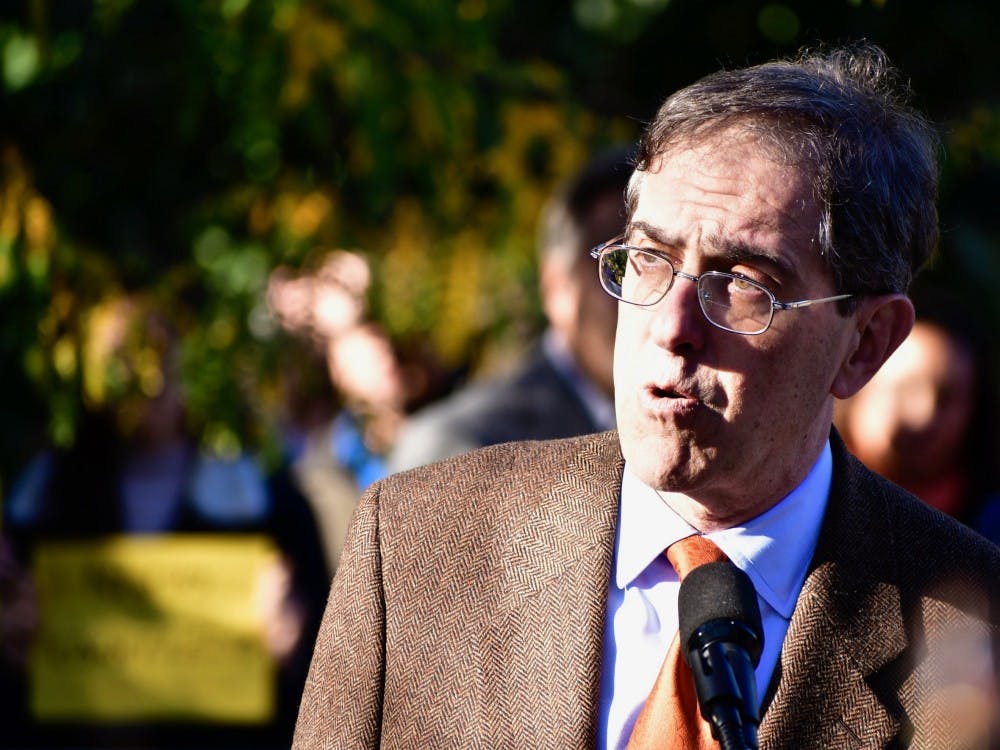
University President Christopher L. Eisgruber
Photo Credit: Jon Ort/ The Daily Princetonian
Eliot Chen ’20 also spoke during the Q&A. He compared the Woodrow Wilson installation, which he referred to as a “monument,” with the campus graffiti pertaining to and preceding the Title IX reform protests last spring. Chen alleged that a student had been fined and put on probation for making the graffiti.
“Why is this monument more just and more okay than hers?” Chen asked.
Hood responded to Chen by saying he did not think his installation was any “more just,” mentioning that he could have easily refused the University’s call for him to create a Woodrow Wilson marker, adding that his acceptance was part of his own, personal “expression” as an artist.
“I applaud all of the advocacy here,” Hood said.
Hood also acknowledged the installation’s change in name during the talk. Initially, the monument was titled “Double Consciousness,” drawn from W.E.B. Du Bois’ 1903 publication “The Souls of Black Folk.”
“It is a peculiar sensation, this double-consciousness, this sense of always looking at one’s self through the eyes of others, of measuring one’s soul by the tape of a world that looks on in amused contempt and pity,” Du Bois wrote. “One ever feels his two-ness, an American, a Negro; two souls, two thoughts, two unreconciled strivings.”
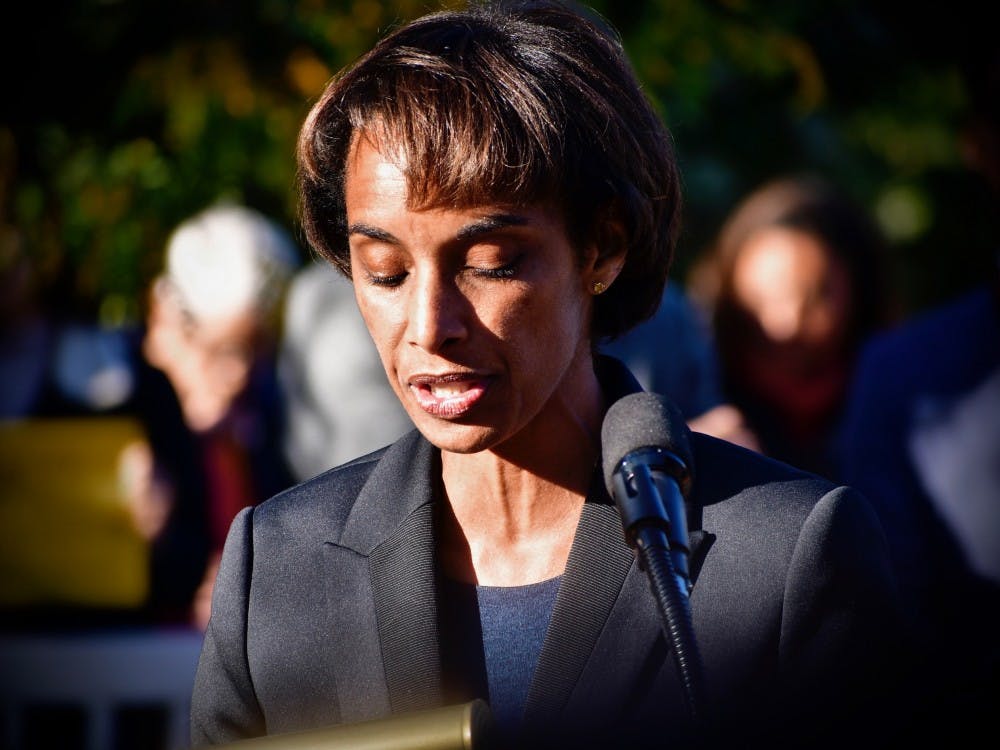
Cecilia Rouse, Dean of the Woodrow Wilson School, speaks at the ceremony.
Photo Credit: Jon Ort / The Daily Princetonian
Hood said it was black students on campus who encouraged him to change the name.
“They said, ‘Mr. Hood, he can’t have that word. You cannot give double consciousness to Woodrow Wilson,’” Hood said. “I said why, and they were like, ‘he didn’t have a double consciousness,’ and I was like, ‘Oh yeah, you’re right.’”
In addition, Hood had originally wanted the installation to be 70 feet tall, but he was informed that such a height would not be feasible. The installation now stands at 39 feet.
Throughout the talk, Minter and Hood emphasized the incremental nature of the University’s approach to change, repeatedly saying that the University “still has work to do.”
“This is not Princeton’s solution to Woodrow Wilson,” Minter said.
The event coincided with the Thrive conference, which celebrated the University’s black alumni. Conference attendees were given priority admittance for the event in McCosh, prior to entry for students and the general public.
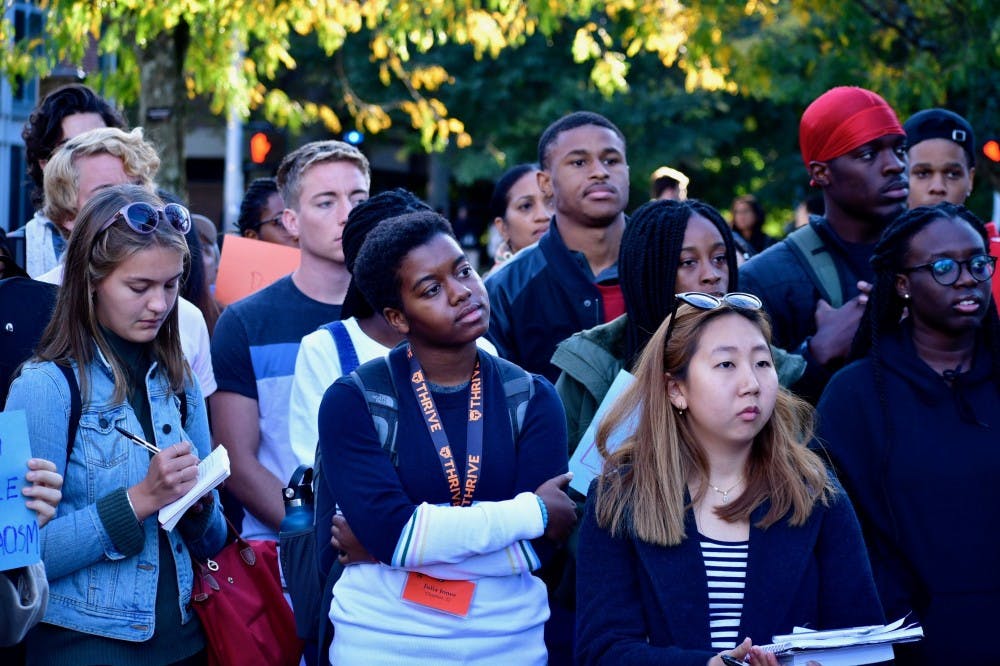
Students listen to alumni and student speakers at the protest against the installation.
Photo Credit: Jon Ort / The Daily Princetonian
After the discussion in McCosh, Rouse and Eisgruber spoke at Scudder Plaza, as audience members from the discussion, as well as a number of protestors, gathered around them. Eisgruber called the ceremony, as well as the installation itself, “important steps in Princeton University’s continuing efforts to speak honestly and completely about its history as we work to build a more fully inclusive campus.”
“Walter Hood’s sculpture will be an engaging, vibrant presence on this plaza,” Eisgruber said. “It is a stimulus to reflection and, as is the case today, an invitation to dialogue. It is disruptive by design.”
“Double Sights” is adjacent to the “Fountain of Freedom” on the Washington Road side of Scudder Plaza. It is a vertical sculpture of two columnar elements, one leaning on the other, wrapped with surfaces of black and white stone-like glass and etched with quotations “representing both the positive and negative aspects of Wilson’s legacy,” according to the Office of Communications.
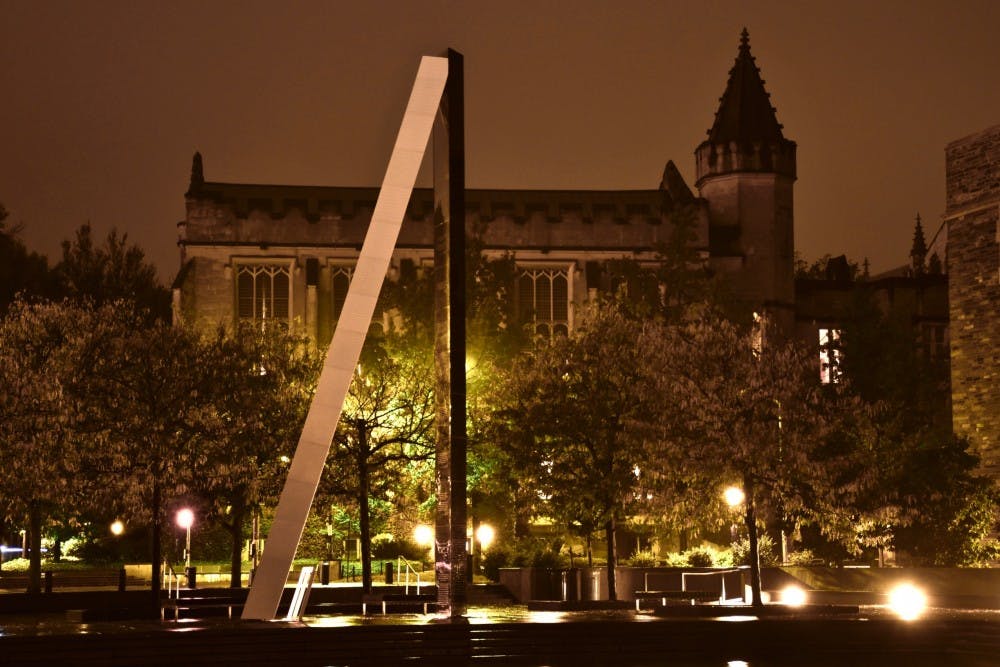
“Double Sights,” viewed across the Fountain of Freedom.





